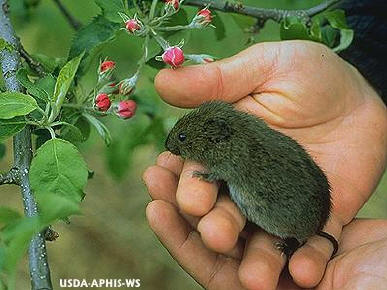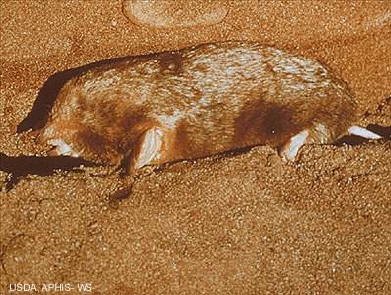Lee Royer
Frederick County Master Gardener
 Nasty little critters are digging unsightly holes and tunnels through Frederick County gardens, lawns, landscaping, and pastures, but what are these vermin? Are they moles or voles? Unfortunately the same well drained loose soils we cultivate are the same ones preferred by moles and
voles.
Nasty little critters are digging unsightly holes and tunnels through Frederick County gardens, lawns, landscaping, and pastures, but what are these vermin? Are they moles or voles? Unfortunately the same well drained loose soils we cultivate are the same ones preferred by moles and
voles.
Which is which?
Size, color, and tail length are similar. Adults may be 3 to 8 inches long, grayish brownish in color with very short tails. Quickly noticeable differences are in the eyes, ears, and feet. Moles appear to have no eyes or ears, yet the feet are large, set near to the body. Vole eyes, ears, and feet are very similar to those of that easily recognized
pest, the House Mouse, and in fact, their common name is Field Mouse or Meadow Mouse. They dig underground burrows with a system of runways often in a tree shape if viewed from above.
 Who is to blame?
Who is to blame?
To make identification trickier, moles and voles are not mutually exclusive. Opportunistic voles will happily run through existing or abandoned mole tunnels. What moles think of this may be unknown, but perhaps don’t care much since a key difference is diet. Moles, related to screws, are insectivores eating earthworms, larvae, adult insects and
other invertebrates. They tend to live at lower levels and spend little time above ground. Voles, true rodents, eat green vegetation, bulbs, and tubers. When winter comes they will eat tree bark at ground level, often doing enough damage to kill. So besides the unsightly tunnels and burrows these two are eating our plants and our beneficial earthworms, a double whammy for
gardeners, homeowners and farmers.
What’s to be done?
If my guess is correct, you don’t really care which is which, you just want to get rid of them or at least stop the damage. That could be more difficult than telling the difference between the two, but approaches are similar.
Predators are a green option. Voles especially are at the mercy of talented barn cats or terriers and wild predators such as foxes and hawks. Smart farmers and homeowners are happy to see a large black or corn snake as they are the perfect mole, vole, mouse, and rat terminators. If you do kill or relocate a large snake from your property, expect
the rodent or mole population to increase significantly. That snake grew to that size from eating something and the balance of power will now be in favor of more rodents and other small mammals.
Traps may be used for either moles or voles. Traps designed for mole tunnels are readily available that may be baited with earthworms or grubs you dig yourself or buy. For voles, regular mouse traps baited with apple slices may be set along their runways and near their burrows.
Poisons sold over the counter or on the internet for either moles or voles are not recommended as products with real effectiveness require special permits and application training. Repellants are even less reliable than poisons. Poisons and repellants always carry the risk that other animals or your water system may be inadvertently harmed.
Read other articles on birds, wildlife & beneficial insects
Read other articles by Lee Royer